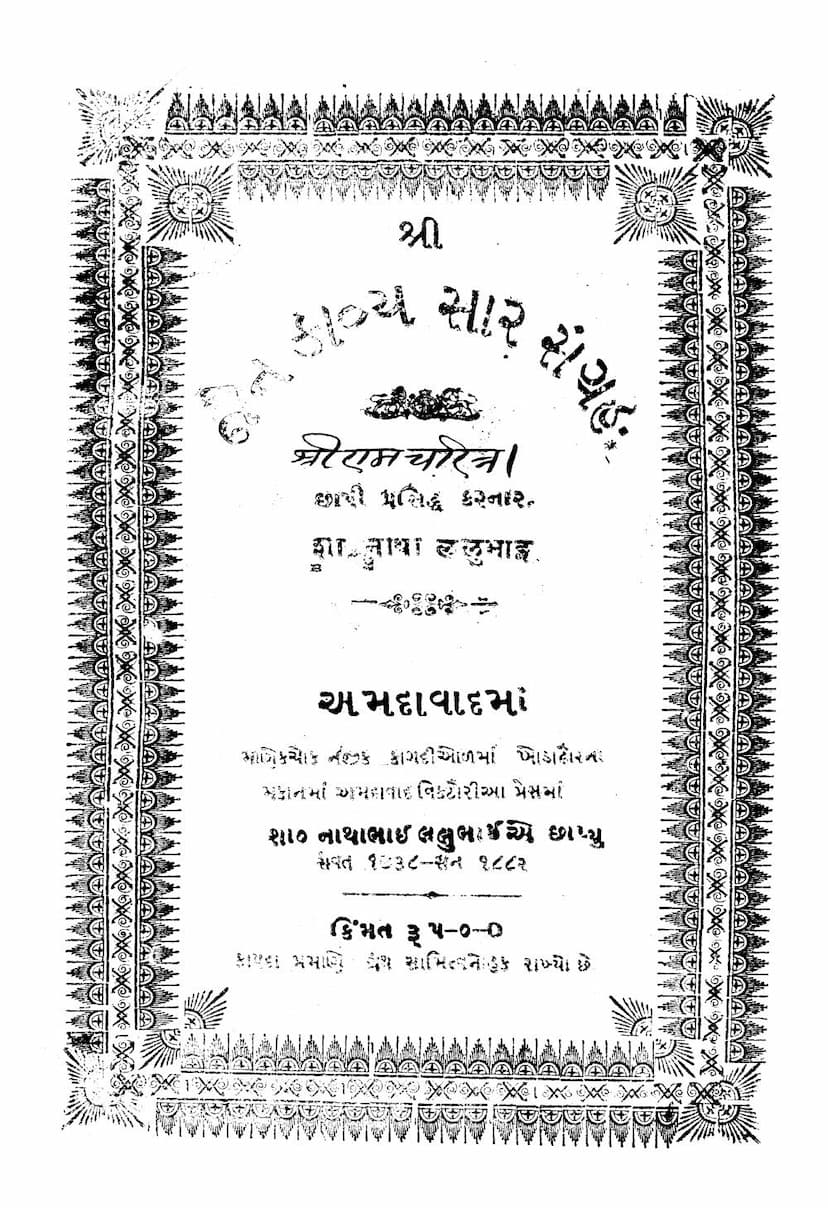Jain Kavyasara Sangraha
Added to library: September 2, 2025

Summary
The Jain text "Jain Kavyasara Sangraha" by Sha Nathalal Lallubhai is a comprehensive collection of Jain literature, primarily focusing on Jain narratives and devotional poetry (kavyas). Based on the provided text, here's a summary of its key aspects:
Overall Nature of the Text:
- Compilative Work: The title "Kavyasara Sangraha" suggests it's a compilation or anthology of Jain poems (kavyas).
- Narrative Focus: The text includes detailed narratives from Jain tradition, most notably the "Shri Ram Charitra" (life story of Rama), which is presented as a central piece.
- Devotional and Didactic: The poems likely aim to inspire devotion, impart moral lessons, and recount the lives and teachings of Tirthankaras and important figures within Jainism.
- Historical and Cultural Significance: The publication details on page 1 (likely the title page or preface) indicate its printing in 1882 (Samvat 1938) by Shah Nathalal Lallubhai in Ahmedabad. This places the text within a specific historical context and highlights its role in disseminating Jain literature.
Key Content Areas and Themes:
-
Shri Ram Charitra (Life of Rama):
- Jain Perspective: The text presents the life of Rama, a significant figure in many Indian traditions, but from a Jain viewpoint. This means his story will likely align with Jain cosmology, ethics, and philosophy.
- Tirthankara Context: The narrative places Rama within the lineage of Tirthankaras, specifically mentioning him as the eighth Baldev and Lakshman as the eighth Vasudev, and Ravana as Mahipal, placing them within the context of the 22nd Tirthankara, Shri Munisuvrat Swami. This is a crucial Jain interpretation of these epic figures.
- Narrative Details: The text delves into the lineage of the Ikshvaku dynasty, the birth of Rishabhadeva, and the subsequent kings. It then moves to the time of Shri Munisuvrat Swami, introducing the characters of Rama, Lakshmana, and Ravana.
- Epic Events: The summary highlights specific episodes such as King Sagar's encounter with a horse that flies into the sky, his subsequent fall, and his discovery of a beautiful woman by a pond. It also mentions the story of Sukeshā, the daughter of King Sulochana, and her abduction by Purnamegh.
- Karma and Reincarnation: The narratives implicitly or explicitly touch upon the Jain principles of karma and reincarnation. For instance, the story of Bhavan and Haridas, who kill each other in a past life and are reborn as Purnamegh and Sulochana respectively, illustrates the cyclical nature of karma.
-
Lives of Other Jain Figures and Figures Reinterpreted through a Jain Lens:
- Tirthankara Mentions: The text mentions several Tirthankaras, including Shri Rishabhadeva (the first), Shri Munisuvrat Swami (the 22nd), and Shri Ajitnath (the second). Their lives and teachings serve as moral exemplars.
- Reinterpretation of Hindu Epics: The inclusion of Ramayana characters (Rama, Lakshmana, Ravana) within the Jain framework is a significant aspect, demonstrating how Jainism integrated or reinterpreted popular narratives to align with its own doctrines.
- Generational Narratives: The text traces the lineage of kings and figures across generations, highlighting the cyclical nature of existence and the impact of past actions (karma).
-
Jain Ethical and Philosophical Concepts:
- Karma: The concept of karma and its influence on rebirth and destiny is a recurring theme, evident in the stories of characters facing consequences for their actions.
- Ahimsa (Non-violence): While not explicitly detailed in the snippets, the Jain ethical framework, which heavily emphasizes ahimsa, would be interwoven into the narratives, especially in the portrayal of characters' actions and their outcomes.
- Moksha (Liberation): The ultimate goal of liberation from the cycle of birth and death (moksha) is the underlying aspiration that guides the characters and narratives towards spiritual upliftment and detachment from worldly pleasures.
- Renunciation: Several characters, including kings, renounce their worldly possessions and embrace asceticism to attain spiritual merit and liberation, a key ideal in Jainism.
- Devotion to Tirthankaras: The text begins with prayers and salutations to Tirthankaras, emphasizing the devotional aspect of Jain practice.
-
Literary Style:
- Poetic Narrative: The text is described as "Kavyasara," indicating a poetic and narrative style, likely using verses (padyas) and prose to tell stories.
- Descriptive Language: The excerpts show descriptive language, especially when portraying characters and settings (e.g., describing Sukeshā's beauty).
Structure and Organization (Inferred):
- Book Organization: The text is divided into "khandas" (sections or books), with mentions of the "first section" concluding with the birth of Ravana and the "second section" beginning with the narrative. This indicates a structured approach to presenting the stories.
- Chronological or Thematic Progression: The narratives seem to progress through different periods and focus on various figures, creating a broader tapestry of Jain history and mythology.
In essence, "Jain Kavyasara Sangraha" is a literary treasure trove that retells familiar epic stories through the lens of Jain philosophy, emphasizing ethical conduct, karma, reincarnation, and the ultimate pursuit of liberation, all presented in a poetic and engaging format.